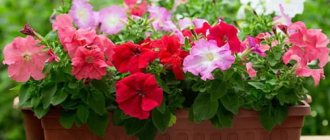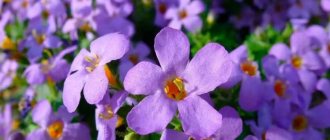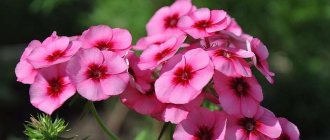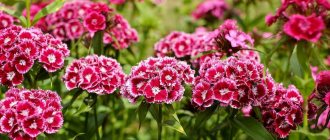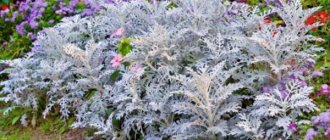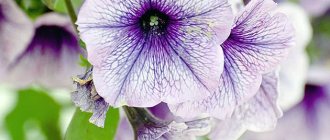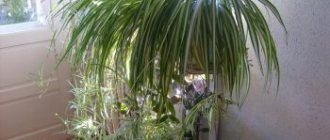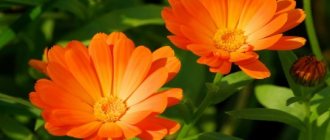Petunia is probably the most popular annual flower. And this is not surprising, because it has long and abundant flowering and a pleasant aroma. The flower can be used in mixborders, borders, vertical gardening, and single flower beds. To enjoy beautiful flowering in summer, you need to grow healthy and strong petunia seedlings. Therefore, it is extremely important to know how to properly care for it at home after sowing and before planting in open ground.
Sowing petunia according to the LUNAR CALENDAR in 2022
To begin with, we provide a list of favorable and unfavorable days in order to know when it is recommended to plant petunia seedlings in 2022 according to the lunar calendar, and when, on the contrary, you should refrain from sowing.
- Favorable days in 2022:
- January
– 3, 8, 9, 10, 11, 15, 16, 23, 24 - February
– 3, 4, 7, 8, 9, 10, 11, 12, 13, 14, 15, 22, 23 - March
– 3, 6, 7, 8, 10, 11, 12, 16, 17, 21, 22, 23, 29, 30 - April
– 3, 4, 5, 6, 7, 9, 12, 13, 14, 15, 26, 27
Unfavorable days for planting will fall, as usual, on new and full moons. Also, if possible, it is better to avoid those days when the moon is in the sign of Aquarius (one of the most barren periods).
- Unfavorable days in 2022:
- January – 2, 4, 5, 18
- February – 1, 2, 16, 28
- March – 1, 2, 18, 27, 28
- April – 1, 16, 23, 24, 25
For those who are used to navigating by the lunar calendar, a list of specific dates is certainly necessary information. However, it is worth little if you don’t know in what month it is better to plant petunia in your region, what is the difference between the planting times for hanging and bush varieties, when you need to plant these plants, based on the length of daylight hours and the required time for the start of flowering. It is this information that will help you start sowing on time, so that the plants will then develop normally and be able to bloom together. We recommend that you continue reading and learn more about planting dates, as well as how to organize the process itself as simply as possible.
Common varieties
Tradescantia indoors - home care
The plant has been known since the 18th century. Breeders began breeding hybrid varieties only 100 years ago. Among the most popular varieties that can be grown at home both in winter and summer, it is worth highlighting several.
Multiflora
Belongs to the category of multi-flowered petunias, which are distinguished by early flowering. During flowering, the bush is covered with luxurious inflorescences, the diameter of which reaches 5 cm. Compact size plants will create a highlight in the interior of a small room. The variety is not picky and easily adapts to new conditions. Can be grown indoors all year round.
Fantasy
A hybrid petunia flower, the height of which is in the range of 18-20 cm. The diameter of the buds reaches 30-38 mm. The flowers are painted in crimson shades with a white star, black and purple tones and a scarlet palette with a cream-colored throat.
Mirage
Terry variety, the diameter of the inflorescences reaches 55-90 mm. The flowers are painted in purple tones with a violet mesh, snow-white, crimson and blue-black palette. Flowering continues until autumn. Experts recommend pruning the plant in a timely manner.
Variety Mirage - a terry variety of crop
Plumcrystals
A variety of crop in which the height of the bushes reaches 25-30 cm. The diameter of the flowers is within 6-7 cm. The flowers are painted in various bright shades, the saturation of which fades gradually. Compliance with the rules of crop care will allow you to get healthy bushes.
Grandiflora
A variety of petunia, the diameter of the inflorescences of which reaches 14-16 cm. There are very few flowers on one bush, but their size characteristics compensate for the paucity. The buds are quite fragile. Even a strong gusty wind can damage them.
Purple Pirouette
A large-flowered variety of ornamental crop, the flowers of which are painted in a rich purple palette. The circular border is white corrugated. Purple Pirouette looks especially impressive in flowerpots that are displayed near herbaceous plants.
Hit parade
Low growing petunia. The flowers of this variety are painted in a varied palette (cream, pink, blue, crimson). The height of compact bushes reaches 35-40 cm. The diameter of the inflorescences is within 9-10 cm. The flowers do not bloom at the same time. The blooming interval is 7-8 days.
Surfinia
An ampelous variety, the diameter of the flowers reaches 8-9 cm. As a rule, the inflorescences are painted in yellow and orange tones. Surfinia is unpretentious. Pots with flowers must be placed on window sills on the south side.
Tumbelina
The Japanese variety of petunia is distinguished by the presence of double inflorescences on the bushes. The buds are painted in various shades. The variety needs diffused lighting and regular watering.
Conchita
This is a miniature variety. During flowering, the bush is dotted with opening buds, the diameter of which reaches 4-5 cm. The shades of the flowers are varied: white, orange, pink, blue and purple.
The Conchita variety is distinguished by its miniature flower size
We choose the timing of when to plant petunia seedlings in different regions
It is important to understand when planting time is in your region. For different climatic conditions, the optimal periods will be quite different.
Middle zone (Moscow region)
The most suitable time throughout the middle zone will be:
February March
Southern regions
Here you can start planting earlier. It is perfectly acceptable to sow:
from the second half of January
North-West, Urals, Siberia, Far East
In these regions, the timing is quite extended and depends on additional lighting when growing seedlings (more on this later) and the location of further planting of seedlings. In general, it is better not to rush and plant during the following period:
end of February – beginning of April
Using petunia in garden landscape design
Petunia is in demand among gardeners due to its bright and rich colors, ease of care, abundant and long-lasting flowering. It is used for landing on:
- flower beds;
- gazebos;
- arches;
- terraces;
- balconies.
The ampelous and cascading varieties planted in pots and cache-pots look original. Bush plants get along well with other crops and are suitable for planting in mixed borders, borders and flower beds.
In conclusion, it is worth noting that we have considered everything about petunias and if you plant petunias responsibly, it will delight the owners with beautiful and abundant flowering from May until the first frost.
How seedling planting conditions affect sowing dates
Now let's look at the important clarifications regarding the above deadlines.
From the moment of sowing petunia for seedlings until transplanting the seedlings to a permanent place, 11-13 weeks should pass.
Focus on these numbers. That is, if you plan to plant seedlings in open ground in early June, then you need to sow in early March. Petunia is a heat-loving plant, so be sober about when it can be moved to a permanent location. The landing conditions for it should be as follows:
- There is no threat of return frosts.
- The soil warmed up to +10-12 degrees.
Think about when this time comes in your area, and count back the indicated 11-13 weeks to determine the earliest sowing time. For example, in the middle zone (Moscow region), the planting time that meets the requirements is in the second half of May, which means that you can sow from approximately mid-February.
When making these calculations, keep in mind that petunia is also very light-loving. If you have phytolamps and the ability to supplement the seedlings literally from the moment of sowing, then you can safely plant the seeds in February or even January, but if not, then you should not sow them before March. With a lack of lighting, seedlings, unfortunately, easily stretch out and become thin and weak.
With additional lighting, petunia can be planted as seedlings much earlier; without additional lighting, it is better not to rush and sow no earlier than March, regardless of the region.
Additional lighting is required in winter
If for some reason you want to start planting earlier, but you won’t be able to provide additional light to the seedlings, then choose the brightest window to place them and in the future be sure to pinch the bushes so that they branch better and are denser, but know that the risk is still very high that young plants will be weakened.
If you plan to plant seedlings not in open ground, but place them, for example, on a warm glazed balcony or in another place where it will be comfortable regardless of the weather, and at the same time you have the opportunity to supplement the seedlings for a long time, then the sowing dates can be moved further the earlier side. In this case, it is possible to sow even at the beginning of January, and get well-developed plants already at the end of March - April. But this is still rather an exception, since mostly petunias, of course, are intended for planting in the open air.
Seedling care and picking
Planting petunia in open ground will go without problems if the seedlings are cared for according to the rules of agricultural technology.
Agrotechnical activities must be carried out according to the rules
Watering
The seedlings are watered at the root using a syringe, pipette, or bulb. The procedure is carried out in the evening once every 2-3 days.
For irrigation, choose settled warm water. They start spraying with a spray bottle when the seedlings get stronger.
Ventilation
The seedlings are ventilated daily. But if at first the film is removed for a couple of seconds, then after the first seedlings appear, the interval is increased to 10–20 minutes.
As the seedlings grow older, ventilation gradually reaches 2 hours a day. While the seedlings are refreshed, the film is wiped dry to remove condensation.
Lighting
The plant needs high-quality lighting. Therefore, daylight hours for petunias last at least 16 hours. If there is insufficient light, fluorescent or photo lamps are used.
Exposure to direct sunlight has an adverse effect on growth. Gardeners help seedlings cope with the problem by shading flowers or changing the location of containers.
Additional lighting
Temperature
Initial room temperature +20…+22 °C. After 20 days, petunia begins to harden. To do this, open the window so that the temperature drops to +16...+18 °C.
In severe frosts, do not open the window, because the difference may be too noticeable.
A month before transplanting into open ground, flowers begin to be placed on an open balcony, loggia or veranda, thereby accustoming the seedlings to low thermometer readings.
Picking
Before planting petunia in a new container, wait until at least 4 leaves appear on the seedlings.
Before picking, the soil is well moistened. A larger container is filled with new soil that has been disinfected.
The sprouts are carefully removed by grasping the young leaves. When digging out roots, help with a knife or sticks. They dig it up together with a lump of earth.
Picking petunia into a new container
A recess is made in a new container, where the sprout is placed along with a lump of earth. The stem is buried to the lower leaves. The earth around is pressed down and then watered. The procedure is repeated after 1.5 months.
When diving, damage to the root is possible. This will not play a negative role for the plant. It is much worse to damage the stem, which can lead to the death of the seedling.
Top dressing
The first time the soil is fertilized before sowing the seeds. The following fertilizers are used:
- Citron - improves root growth;
- Etin - stimulates the growth of seedlings;
- Uniflor - supplies essential microelements;
- Hydrogel - regulates soil moisture and seed germination.
10–15 days after picking, fertilizers are applied. Further feeding is carried out once every 14 days. Alternate complex fertilizers and growth stimulants.
Fertilizers are applied according to the standards. An overdose is dangerous for seedlings.
We sow ampelous and bush petunias at different times
Depending on what type of plant - hanging or bush - you plan to grow, the optimal planting time will be slightly different.
- Reference:
- Ampelous - have long (50-120 cm) flexible shoots. Ideal for hanging planters and vertical gardening.
- Bush - have erect shoots, either compact (up to 30 cm), or spreading and quite long (up to 60 cm). Used in various flower beds.
Ampelous varieties and hybrids require a little more time to grow and develop. They are sown earlier.
It is better to sow ampelous petunias 2 weeks earlier than bush petunias.
Hanging varieties are very effective in hanging flowerpots
Possible problems and their solutions
Healthy plants
We have put together a number of recommendations on how to solve problems that arise with petunia.
1 Young plants develop poorly
This is possible at temperatures lower than recommended. Petunia is a cold-resistant plant and can survive even after light frosts, but the optimal temperature for its normal growth and development should not be below 10 ° C.
2 The plant turns yellow from the base, the leaves wither
Yellowing can occur if the roots rot from excess moisture. Before watering petunia, be sure to dry the soil. If petunia is growing in a container, you need to provide drainage using perlite or expanded clay.
White coating on petunia leaves or powdery mildew
3 There is a gray coating on petunia leaves
This plaque is powdery mildew. To avoid infection, plants should be treated with drugs against this disease from the beginning of June to the end of August once every 2 weeks. When spraying with preparations, you need to try to get inside the bush - it is there, from the lower leaves, that powdery mildew begins to develop.
4 The leaves are growing well, but there are very few flowers
This situation is a consequence of excess fertilizer. To solve the problem, it is recommended not to feed the plant for one and a half months.
The beginning of summer is the time of aphid attack
5 Green insects are visible on the leaves and inside the flowers, the leaves have become sticky
These insects are green aphids. It is necessary to treat the plants with an insecticide, diluting it according to the instructions. You need to repeat the treatment once every 2 weeks until the pests completely disappear.
6 Petunia withered and drooped
This situation is possible if it is too hot and dry. It is recommended to water the plant generously, but allow the soil to dry thoroughly before the next watering.
Petunia drooped
7 Young plants are thin and elongated
Sprouts stretch out if it is too dark. It is necessary to provide petunias with full sunlight.
Attack on Petunia, similar to the Tobacco Mosaic
8 Yellow spots appeared on the leaves, and dark spots appeared on the peduncles
This is the tobacco mosaic virus. To avoid infection, you need to disinfect the container before planting petunias in it.
Deciding when to sow in order to achieve flowering in the right month: April, May, June, July
Petunia seedlings, as a rule, are planted already flowering, which is due to the peculiarities of the growing season of this crop: from sowing to planting, as already mentioned, approximately 3 months pass, and less - about 2.5 months until the flowers appear (the first buds may appear even earlier, especially if the variety is early). So it turns out that young plants often bloom even before they are transplanted to a permanent place.
Therefore, if you need to get flowering bushes by a certain date, then subtract 2.5 - 3 months from it.
It turns out:
- To achieve flowering in mid-April, you need to sow in mid-late January (mandatory long-term additional lighting will be required)
- To achieve flowering in mid-May, you need to sow in mid-late February (at first you will need additional lighting)
- To achieve flowering in mid-June, you need to sow in mid-late March
- To achieve flowering in mid-July, you need to sow in mid-late April
Popular types and varieties of petunias
There are a huge number of varieties and types of petunias bred by breeders. They all differ in bush shape, size, and colors.
Large-flowered petunia (grandiflora)
A popular species that attracts with early and abundant flowering. The best varieties are:
- Blue waterfall . It grows quickly, begins to bloom early, and continues until the first frost. The variety is suitable for hanging gardening. Even under unfavorable conditions (rainy or dry weather), the plant retains its decorative qualities;
- Limbo . It is a dwarf hybrid, about 15 cm high. Suitable for home breeding. The variety is characterized by the purple color of its buds. Although one bush can contain multi-colored inflorescences;
- Alderman . Attracts with blue-violet inflorescences that bloom for 4 months. The variety is suitable for group planting.
Choosing suitable seeds
Further subtleties concern not the timing, but the preparation and the planting process itself. It must be said that there are quite a lot of nuances in this matter. First you need good seed material. After a certain time, it loses its viability, so you should avoid overdue ones that have been stale.
The shelf life of petunia seeds is up to 5 years.
But if possible, it is, of course, better not to keep them for that long - as practice shows, their optimal germination is within 3 years. However, during storage it is important that they are kept in suitable conditions: a dry and dark place. Best when cool. Sometimes there is a direct indication on the packages that it is recommended to store them in the refrigerator - at such temperatures, viability lasts longer. It follows that:
For better germination, we take fresh seeds - 1-3 years old.
Older (up to 5 years) planting material can also be used, but only if all storage conditions have been met, and then there are no guarantees in this case.
The bags are best stored in the refrigerator
Petunia seeds are very small (0.5 mm in diameter) and dark, merging with the color of the soil. Planting such crumbs is problematic, so manufacturers have now mainly switched to producing them in pelleted form: they are covered with a special colored nutritious shell, which makes them larger and more noticeable.
At the stage of selecting varieties and hybrids for planting, decide what type of seeds you will sow - regular or pelleted. Both have a number of advantages and disadvantages.
Regular seeds:
- Minuses
- very small
- poor assortment today
- indistinguishable on the ground
- pros
- cheap
- no additional dissolution of the shell is required
Dried seeds in capsule
Dried seeds:
- Minuses
- the shell sometimes dissolves with great difficulty
- expensive
- small quantity per package
- You may get empty pellets
- pros
- larger than normal size
- have a noticeable color
It is better to take planting material from trusted agricultural companies, since the germination of petunia seeds is a sore subject. Even fresh ones, alas, can sprout poorly.
Due to their extremely small size, petunia seeds are difficult to plant, and for the same reason they are not subjected to any pre-sowing treatment - this is simply unrealistic.
Pinching
Pinching is the removal of the top part of an overgrown shoot. It is an important stage in growing and caring for seedlings; it is necessary for the formation of petunia and future lush flowering. This effect is achieved due to the elimination of the elongated upper part of the plant, which promotes the growth of shoots in different directions.
These instructions will help you correctly pinch seedlings at home:
- The activity should be carried out only when the flower has grown, stretched, and become stronger; it should grow rapidly upward, and it should also have two or three pairs of true leaves.
- Pinching is best done after picking or transplanting into open ground.
- For proper pinching, you need to determine the right place on the stem (it is located approximately three to five leaves from the bottom of the plant). Then you should pinch off the top shoot in this place.
Video: how and when to pinch petunias.
Preparing the soil
Any high-quality commercial soil for seedlings or universal soil is suitable for planting petunias. In this regard, the plant, fortunately, is not overly capricious - the main thing is that the soil is loose, nutritious and can sufficiently retain moisture. The soil reaction should be neutral or slightly acidic.
If possible, the soil should be steamed (or calcined in the oven) for 40-60 minutes to prevent the seedlings from developing blacklegs.
Good soil is the key to success
Before pouring it into the container where planting will take place, all large foreign elements - roots, stones, lumps, etc. - are first removed from the soil. You can also sift it so that it has a uniform and loose structure. If possible, it is worth adding a little vermiculite.
It is also possible to independently prepare the soil mixture, although from the point of view of the ratio of results and labor costs, this option is not the most optimal. Nowadays, it is much easier to purchase ready-made soil for planting, especially since you only need a little of it at first. In general, we present the composition and proportions for the mixture with your own hands, rather just in case: 1 part humus, 1 part leaf soil, 1 part turf soil, 1 part lowland peat, ½ part sand.
Diseases and pests
Petunia is unpretentious and is rarely affected by pests and diseases with quality care. But any gardener should know what problems he may encounter when maintaining this plant.
Fungal diseases of petunia:
- "blackleg";
- gray rot;
- white rot;
- wet rot;
- brown spot;
- late blight
If the stems of a plant are strewn with black, gray or white spots, become wet, wither and rot, then most likely it is affected by a fungus. The reason for this is high humidity, high temperature, lack of light or dense sowing.
Increased soil acidity and oversaturation with nitrogen fertilizers also negatively affect plant health. First of all, prevention will help you avoid trouble.
You should not thicken the seedings, use soil from the garden or greenhouse without preliminary steam treatment, do not overdo it with nitrogen fertilizers and regularly remove the affected parts of the plant.
Important! Petunia is afraid of rain. Flower petals can be severely damaged in heavy rainfall, giving them a sloppy appearance. In prolonged rainy weather, petunia flowering may stop altogether.
Bacterial and viral diseases of petunia:
- Leaf galls.
- Cucumber mosaic virus.
- Tobacco mosaic virus.
- Y and X potato viruses;
- Tomato aspermia virus.
- Tobacco necrosis virus.
These diseases are rare, but can spread rapidly from plant to plant or be transmitted through seeds. When petunia is infected with viruses or bacteria, the appearance of the flower changes. Spots appear on the leaves, their shape and appearance change. The flowering of the plant sharply decreases or stops, the flowers become small and spotty. Treatment consists of immediately destroying the diseased plant.
Petunia pests:
- aphid;
- whitefly;
- thrips;
- spider mites;
- slugs
Petunia is vulnerable to pests when it is in seedlings. Signs of disease include wilting and yellowing of leaves, and the presence of pests on the stems and leaves. The fight is carried out using various chemicals.
Selecting containers
Option 1. The classic method when sowing petunias is to plant a large number of seeds in common containers with further picking. To do this, it is optimal to use plastic containers with tight-fitting transparent lids. If there are no lids, think in advance how you will cover the containers at the initial stage, since they must be covered on top with something moisture-proof and transparent (glass, plexiglass, film).
Sowing in a common container
Regular food containers with lids are a great planting solution.
Container sizes need to be small, since petunia seedlings are very small.
Don't forget about drainage holes in containers - they can be made in thin plastic using a soldering iron or a hot awl.
Option 2. In addition, there is an alternative type of sowing: planting in individual containers without picking. Such individual containers can be individual small glasses, cassettes or peat tablets.
Sowing in cassettes
Which sowing option to choose is largely dictated by the type of seed. Usually:
Ordinary ones are sown in a common container, and panned ones are sown in individual containers.
At the same time, among the forms of individual sowing, the undisputed leader today is planting in peat tablets. Sowing in cassettes or cups is a little less common. The main subtleties of planting in peat tablets will be discussed a little further.
Growing petunia seedlings
To get strong and high-quality seedlings, you need to be careful when choosing containers and soil. The seedling boxes should be made of wood, plastic or ceramic. Containers should be wide and of medium depth. Drainage holes are required. You can use plastic disposable food containers.
It is necessary to put drainage at the bottom of the container. You can use expanded clay, pebbles. You can buy special drainage at a flower shop. This is necessary so that air passes to the roots and water does not stagnate in the soil.
Then the seedling containers should be disinfected. You can use Formalin or a solution of potassium permanganate. After processing, the container should be thoroughly rinsed with water. If seedlings are planted in a wooden box, a layer of paper, preferably thick paper, should be placed on the bottom.
Sow in a common container: classic method
When planting in a common container, it is first filled with soil with a layer of 4-6 cm. There should be about 3 cm between the soil level and the upper edge of the container so that the seedlings have enough vertical space. The soil is leveled, compacted and watered abundantly. After this, they begin sowing. Regular (not coated) seeds are poured onto a light plate, and using a toothpick or wooden skewer, previously soaked in water, they are transferred one by one to the surface of the soil.
The seeds are laid out on the surface, not buried and not sprinkled with soil on top.
The peculiarity of sowing petunia is that the seeds should be placed ON the ground, and not in depth. If there is a layer of soil on top, they will not germinate.
After the required number of seeds have been spread out, they are sprinkled with water from a spray bottle on top, and then the container is closed with a lid and put in a warm place.
Petunia: care and cultivation at home
Every person who is going to grow petunia from seeds should know how to properly care for it.
Temperature
In order for such a flower to bloom profusely, it must be grown at the optimal temperature. Temperatures should be at 18-22 degrees Celsius. In such conditions it will bloom within 4-5 months.
Important! Petunia can also be grown at lower temperatures. However, at low temperatures, problems with flowering may occur.
Lighting
The window sill is the best place to grow petunia in an apartment
When growing this double flower, you need to monitor the lighting. Especially if it grows not on the street, but in an apartment. The length of daylight for an adult plant should be at least 12 hours. Therefore, in winter, lighting devices will have to be installed near the planted bushes to obtain additional light.
Watering
Many novice gardeners are interested in how to properly water petunias. This must be done very carefully so that a lot of liquid does not fall on the surface of the sheet plates. In the summer, you need to water daily so that the soil is not dry. During the rest of the year, the flower is irrigated once every 3-4 days.
Spraying
After planting, petunia needs to be sprayed periodically, especially in summer. For this, water heated to room temperature is used. It is evenly sprayed onto the stems with a special sprayer.
Important! When spraying, do not use cold water, as it can harm the plant.
Humidity
To get abundant flowering, you need to monitor the humidity of the soil and air. The plant needs moderate moisture and therefore does not like waterlogged or dry soil. Wet soil can cause the development of rot and other dangerous diseases. Dry soil also negatively affects flower development.
Priming
Peat is an essential component of the soil mixture for flowers.
It is necessary to plant seeds and grow seedlings in the most suitable soil for such a plant. For planting petunia, soil that contains the following components is suitable:
- peat;
- turf land;
- river sand.
Important! To prepare the soil mixture, the listed components must be mixed in equal quantities.
Feeding
While growing petunia, it is necessary to periodically feed it with fertilizers. The first time this should be done two weeks after planting the seeds. During this period, the soil is watered with a weak manganese solution. Then the flower needs to be fed with mineral nitrogen-containing fertilizers at least once a month.
We sow in a common container: in the snow
Distributing microscopic seeds one after another is a tedious task, so various tricks are used to make the process easier and faster. The most common one is to use snow.
The soil is placed in the container in the same way as in the previous (classical) planting method. Then clean snow is laid out on top in a continuous layer (1.5-2 cm thick) over the entire surface, after which the seeds are carefully scattered over the snow, trying to do it as evenly as possible. Dark dots are clearly visible on a white background, and if desired, they can be redistributed over the surface using a toothpick. The snow is then allowed to melt and the seed appears on the ground as required.
Sowing in the snow
When using this method, the container must have drainage holes so that after the snow melts, excess moisture can drain.
The planting material is sufficiently moistened, so no additional spraying is needed. The container is covered with a lid, glass or film and placed in a warm place.
DIY vertical flower beds for petunia
In gardening stores you can find ready-made multi-tiered structures. But vertical flower beds are easy to make with your own hands. They will decorate your garden, balcony, apartment or gazebo.
Most often they are made from scrap materials:
- Pots and containers. They are arranged into a pyramid, placed on ropes on both sides and hung.
- Plastic and metal wide pipes. Round holes are cut out on the sides of the pipe. Petunia is planted in them.
- Rabitz. It is rolled into a cylinder or cone.
- Wire. Large, voluminous geometric or fantasy figures are made from wire in which flowers are grown.
- Barrels with humus. Holes are made on the sides of the barrel into which petunia is planted. This humus cooks faster.
- Tires. They are placed on top of each other so that there is room in each tire for a flower.
Prepared vertical flower beds are filled with the same soil mixture as for seedlings. Such flower beds need more frequent watering. Gardeners recommend building devices for drip moistening of the soil.
Otherwise, caring for flower beds is no different from growing petunias in open ground. For the winter, the structures are removed indoors.
We use an alternative approach: we sow in peat tablets
For pelleted seeds, a good planting method is individual sowing in peat tablets.
To do this, place dry peat tablets in a plastic container and fill them with water. Wait for swelling, adding water if necessary. When it is clear that the tablets are already well soaked and have reached their maximum size, excess water is drained and sowing begins. Pelleted seeds are poured onto a saucer and, with a damp toothpick or skewer, transferred one at a time to the center of each peat tablet. Just as when sowing in a common container, the seeds should not be buried under any circumstances - they should lie on the surface of the substrate.
Peat tablets are very convenient for sowing pelleted seeds
It is very important, after the seeds are spread out, to generously spray each tablet on top using a spray bottle.
The pelleted seeds must be generously moistened, otherwise their shell may not dissolve and they will disappear without hatching.
After this, the container with the tablets is closed with a lid and placed in a warm place.
How to grow petunia from seeds correctly
Growing petunia seedlings is not difficult, but you need to understand that the seeds of this plant are small and cannot be covered generously with soil. They simply will not be able to penetrate through a thick layer of soil and the crops will be ruined. But every stage in the process is important: from selecting seeds to planting in open ground.
When planting flowering seedlings, flowering will last until September. Petunia is a low plant, so they are planted along the edge of the flower bed.
Seeds
If you buy seeds, be sure to pay attention to the manufacturer, the integrity of the packaging and expiration dates (it is better to choose those that were collected last season). Please note that there are up to 500 different varieties in stores, so immediately decide what color of the plant you want, the shape of the flower (simple or double). Seeds are available in different forms: loose, granules or dragees. The packaging also varies: bags, granules or flasks. In the latter, as knowledgeable gardeners say, the seeds are of high quality and provide 100% germination. How to prepare the seeds yourself will be described below.
Before sowing, the material should be stratified, that is, kept for 7-10 days at sub-zero temperatures. There is no need to soak the seeds. If you sow seeds in snow, you can skip the stratification process.
There are up to 40 types of petunias.
Priming
If you buy soil in a store, choose the most crumbly and structured soil. Be sure to buy additives such as vermiculite and agroperlite, which will saturate the soil with a sufficient amount of oxygen.
To prepare your own material, you need to mix equal parts of soil from the garden, peat, sand and humus or leaf/turf soil, compost, humus and river sand.
It would be a good idea to mix mineral complexes into the soil for flowering plants. How to choose and prepare soil for seedlings
Regardless of the type of soil, it must be calcined in the oven and watered with a solution of potassium permanganate or Fitosporin. Planting can begin after the ground has cooled.
Sowing
To plant seeds, it is better to choose the morning or afternoon of “Women’s Day”: Wednesday, Friday or Saturday. Detailed sowing methods are discussed above. You can also use snail. It is prepared like this:
- take the backing that is used when laying the laminate and cut a piece of it 15 cm wide and 20 cm long;
- put 3-4 layers of regular toilet paper on the inner layer;
- moisten the paper generously;
- sprinkle all layers with a small layer of soil up to 5 mm;
- Having retreated 3 mm from the edge, we begin to lay out the seeds;
- moisten with plenty of water again;
- cover with plastic wrap and place under the phytolamp:
As soon as the first shoots appear, the film will need to be removed and soil should be added from time to time so that the shoots stretch upward. When the first leaves appear, the snail needs to be rolled up and secured with an elastic band.
Regardless of the choice of sowing, you need to remember a number of rules:
- the container, soil and seeds must be pre-prepared and processed (this is written in detail in other sections);
- Petunia seeds should not be immersed deep in the soil;
- the soil should be abundantly moistened before sowing;
- you can water the seeds immediately after sowing only from a spray bottle (when planting on snow, this watering is not necessary);
- after sowing, the container must be covered with glass or film and placed in a warm place;
- keep the closed container in the sun;
- for new hybrids of early seedlings it is better that the temperature is 20-25 degrees Celsius, for old varieties - 17-18°C.
- Before sprouts appear (10-12 days), moisten the soil with a spray bottle, then apply root watering using a syringe.
